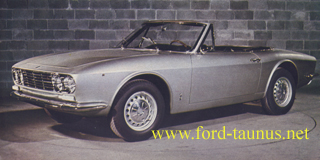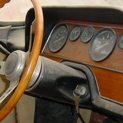 |
OSI (Officine Stampaggi Industriali) was founded in 1960 as a subsidiary of Ghia to build short series of cars such as the Innocenti Spyder and the coupé version of the Fiat 2300 . Special bodies were constructed on the most diverse chassis and running gear. The prototype Ford OSI 20m TS made its appearence in 1966. The car was shown at Geneva and the following year went into production. Ford shipped the appropriate parts from Cologne to Turin and received completed cars back. The car was slightly longer and wider than the standard Ford Taunus. When the 20m TS went into production, some 800 people worked for OSI and at some moment they were producing 15 cars/day. The OSI design team was headed by chief designer Sergio Sartorelli, the type 34 VW Karmann Ghia designer. In the 1967 Turin Motor Show the cabrio version of the OSI was presented. Only one unit was produced and it is currently being rebuilt in Wiesbaden, Germany.
To fully understand the history of the Ford OSI 20m TS we must start many years before Officine Stampaggi Industriali was created.
Keep visiting, it will be improved in the next days.
GHIA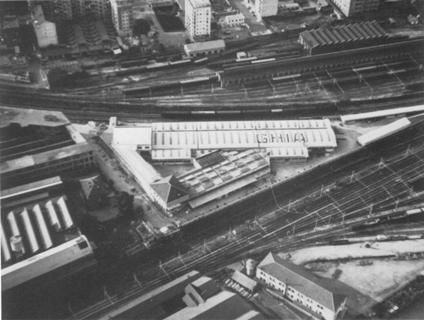
Carrozzeria Ghia SpA was established in 1915 by Giacinto Ghia and Gariglio as Carrozzeria Ghia & Gariglio, located at 4 Corso Valentino in Turin. Ghia initially made lightweight aluminum-bodied cars, achieving fame with the Alfa Romeo 6C 1500, winning Mille Miglia (1929). Between the world wars, Ghia designed special bodies for Alfa Romeo, Fiat, and Lancia, one of the most famous was the Fiat 508 Ballilla sports coupe (1933). The factory was rebuilt at Via Tomassi Grossi, after being demolished in an air raid during World War II (1943). After the Second World War Giacinto Ghia was a broken man because the Allied bombers had hit the Ghia works and nothing had remained. He returned to Torino to supervise the reconstruction of the factory but suddenly died on 21 February 1944. He was only 56 years old. Ghia's widow wanted to continue the name Ghia and offered what was left of the company to two of Giacinto's best friends, Giorgio Alberti and Mario Felice Boano. The latter took control as he was offered the position of director and soon re-established Carrozzeria Ghia. Four years later the company moved to new premises at Corso Unione Sovietica. To handle the newly-forged links with Chrysler, Boano brought in Luigi Segre, a remarkable designer/businessman (commercial director of SIATA), aged only 30. With Segre on his side, Boano saw many foreign firms ordering Ghia designs, such as Ford (the Lincoln Futura concept car), Volkswagen (the Karmann Ghia), and Volvo (the Volvo P1800). 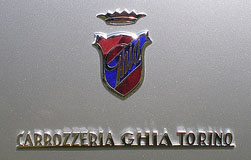
Chrysler and its designer Virgil Exner became a close partner for 15 years, resulting in eighteen Chrysler Ghia Specials (1951-53), the K-310, the Chrysler Norseman, the Crown Imperial limousines (Jackie Kennedy, Nelson Rockefeller, and other luminaries owned one), and others. There are even a few Ghia-bodied Ferraris. Ghia also participated in the short-lived Dual-Ghia venture, with it's production being only just over 100 cars. But the reason for the cessation of Dual Ghia production wasn't due to a shortage of people who could afford Dual Ghias but to a rash of warranty work. The cars just hadn't been built for road use. The workmen didn't understand that these cars were going to be operated in all kinds of roads. They used plenty of body filler to get the smooth lines of the Dual Ghias just right so that when the cars were driven on rough roads, the filler dropped off in lumps. Production by Ghia was always in very low numbers, giving the company's products even greater exclusivity than those of the other Italian coachbuilders. In early 1953 Mario Boano left Ghia to open up his own carrozzeria together with his son Gian Paolo and Luigi Segre took over. In 1957, after designing the Volvo P1800 coupé Ghia moved again in order to increase output, taking over premises in the via Agostino da Montefeltro (formerly occupied by a small steel milling and laminating company) just within a few miles from their old building. Unfortunately Segre died in February 1963 and in September Segre's widow, Contessa Luisa, sold 75 percent of Ghia to Leonidas Ramadas Trujillo son of the recently deposed dictator of Dominica. In 1967 Alejandro De Tomaso, with backing from Rowan Controller, an US corporation run by his brother-in-law, acquired control of Ghia. Ford Motor Company purchased 84 percent of Ghia from Rowan Industries in 1970. Three years later they purchased the remaining 16 percent.
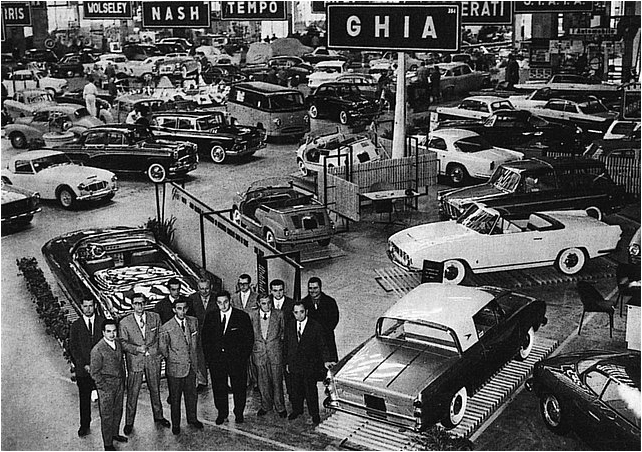
Above is a picture of the Ghia-Monviso stand and team in the 1957 Turin Salon. First on left is Tom Tjaarda, second Sergio Coggiola and third is Sergio Sartorelli. The man in dark suit on center is Luigi Segre. Move your mouse over the picture to know the team.
Officine Stampaggi Industriali
The episode of the Dual-Ghia (to be done soon...) had proved that the company was really not capable of undertaking even modest series production; but now Segre had shown handsome new body designs to Fiat (the 2300S coupé) 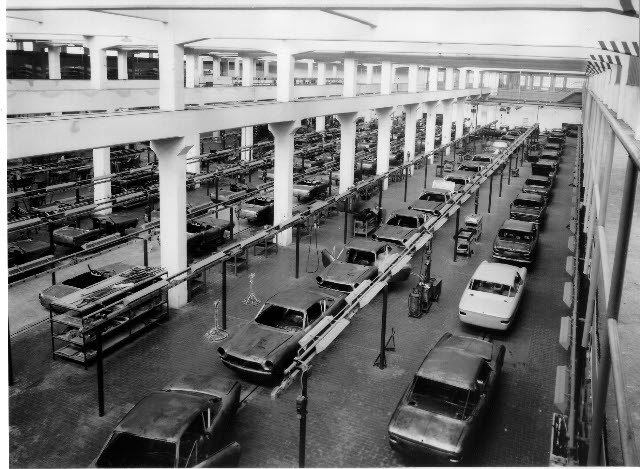 and Innocenti (the 950 spider) and secured contracts to build these cars in quantity. In order to obtain the space and finance to undertake these contracts, Segre sought assistance from the Olivetti business machine company; as a result, a new corporation was established jointly by Ghia and Fergat, a stamping and Wheel making company owned by Olivetti. The new firm, based just across the Via Agostino da Montefeltro from Ghia, was called OSI; the initials stood for ‘Officine Stampaggi Industriali’ (Industrial Stamping Workshop), though some said they really signified Olivetti Segre Innocenti… The name derived from the one of a small mechanical company, Apparecchio OS, that had a shed near Ghia and belonged to former associates of Segre. With a full paid up capital of 275 million lire, ‘OSI entered the automotive industry in a specially favourable and lively period of the national and world economic life’. The corporation’s president was Arrigo Olivetti, while Segre was managing director; its plant covered 21.000 sq. m and incorporated two continuous loop production lines, with provision for a third, plus a 780 m long paint line. It employed some 600 people and could turn out aproximately 50 cars a day.
and Innocenti (the 950 spider) and secured contracts to build these cars in quantity. In order to obtain the space and finance to undertake these contracts, Segre sought assistance from the Olivetti business machine company; as a result, a new corporation was established jointly by Ghia and Fergat, a stamping and Wheel making company owned by Olivetti. The new firm, based just across the Via Agostino da Montefeltro from Ghia, was called OSI; the initials stood for ‘Officine Stampaggi Industriali’ (Industrial Stamping Workshop), though some said they really signified Olivetti Segre Innocenti… The name derived from the one of a small mechanical company, Apparecchio OS, that had a shed near Ghia and belonged to former associates of Segre. With a full paid up capital of 275 million lire, ‘OSI entered the automotive industry in a specially favourable and lively period of the national and world economic life’. The corporation’s president was Arrigo Olivetti, while Segre was managing director; its plant covered 21.000 sq. m and incorporated two continuous loop production lines, with provision for a third, plus a 780 m long paint line. It employed some 600 people and could turn out aproximately 50 cars a day.
According to Virgil Exner Jr. in a August 1989 interview to David Croppen of the Edsel Ford Design History Center, "[Luigi] Segre sought to expand with a new company right across the street called OSI. OSI was a combination of [Arrigo] Olivetti, Segre and [Ferdinando] Innocenti. Innocenti was famous for the motor scooters. They were right around the corner from the Ghia factory. Olivetti was the typewriter people, also in the neighborhood. It was in 1960 or '61 that Segre got together with Innocenti and Olivetti and invested money in a new, modern plant across the street from Ghia, and the three partners named it OSI. The initial product was a small special-bodied Austin/BMC coupe, sports car. I think it was based on the small Austin Healey/MG Sprite components. They also produced a Fiat 1500 sports coupe, which I had something to do with the design of on my consultantship basis. Then they were sold out later after Segre's death and ceased to become OSI."
Although it sounds credible, Mr. Paul Breuer, former OSI staff, thinks Innocenti was not a partner.
Another interesting comment, made by Dr. Felice Calissano (in a March 2001 AISA conference about Ghia) at some time Direttore Amministrativo of Ghia: "...when was dealt to produce in truly industrial amounts of the Innocenti Spyder and Fiat 2300 coupé, [Luigi] Segre made an agreement with other persons and OSI was created. The name derived from the one of a small mechanical company, Apparecchio OS, that had a shed near Ghia and belonged to former associates of Segre, that Segre “throw out”. From this society, that abandoned the mechanical activity, OSI was born with an unit of metal sheets stamping and a production line of Fiat 2300 and the Innocentis."
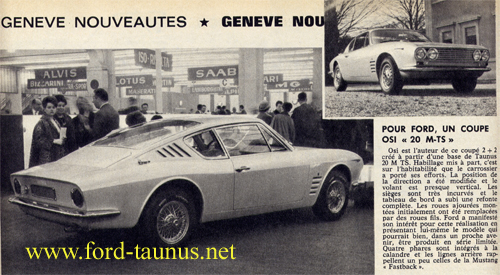
This picture was taken on March 1966 Geneva Auto Show. It is from April 1966 edition of the French magazine L'automobile. Note the fuel tank cap, the fenders' holes and the side blinkers, all disappeared in the production version.The front and back emblems were not present also. The smaller picture shows the car with the regular OSI wheels, from Fergat. The car was shown also with Borrani wire wheels.

The Italian magazine Quattroruote also from April 1966 had this full color page. The text explain that the car was shown in the Ford stand and not in OSI's as we could think. At that time no one could know if the car was going to be produced. The car interior is different from the production car.
Here are two pictures of the only OSI 20m TS spider ever built.
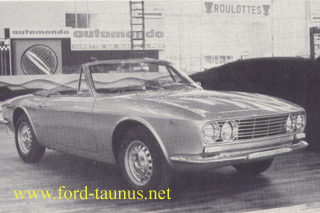
The picture above was taken on 1967 Turin Motor Show and it was the last appearence of any OSI in such events. Check out the number 0999 on my VINs page and you can see the evolution of its restoration.
